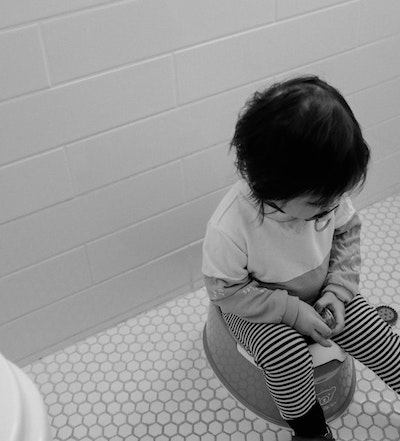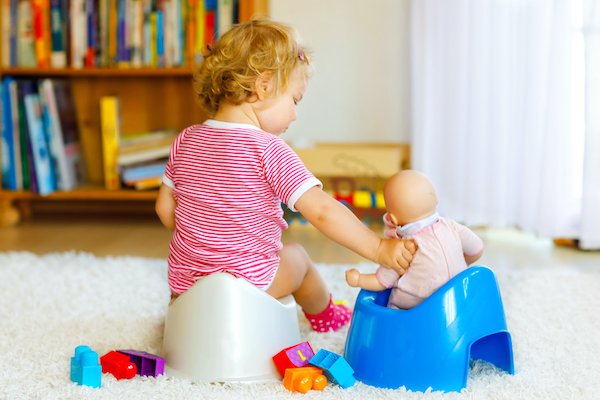Have you noticed some changes in your cute little one’s behaviour when they pee or poo? Are you wondering when to start toilet-training your toddler? Or are you merely curious about when to introduce the potty to your toddler? Then let’s dazzle together and share insights on how to go about potty-training your toddler!
Potty-training is a big step for your toddler’s growth and development. After being able to feed themselves, I see toilet-training as a second stage or step to developing certain independence from you (parents).
You may have noticed or realised that your toddler can communicate when they need to use the toilet or perhaps become uncomfortable as soon as they wet their diapers or poo on themselves.
Every toddler is different, and so do the strategy that will work for each of them. Here are general practicable tips to go about potty-training your toddler.
1. Know when your child is ready
Most times, it is better not to enforce potty-training on toddlers when they are not ready. Understand and know when your toddler is ready for it. If you try to enforce it too early or when they are not ready, you might end up being discouraged and worn out in the whole process.
Toddlers between the ages of 18 - 36 months of age tend to be ready for potty-training. However, let your child take the lead and guide you when he/she is ready.
The question should be - how do you know when your child is ready for potty-training? Some of the signs that your cute little one is ready include:
being uncomfortable when they pee or poo on themselves.
letting you know when they want to pee or poo.
removing his/her diaper by himself/herself.
staying dry for up to 2 - 3 hours.
they seem uninterested in wearing diapers, and so on.
Just study your child and understand their way(s) of communicating their need(s) to you.
Subscribe to Dazzling Insights Blog
You will be notified as soon as a new article is published
2. Don’t be in a hurry
I would advise parents not to be in a hurry to potty-train their toddlers. If you try to do this too early, it might take a longer time than necessary to potty-train your child. Potty-training is a major physical and behavioural attribute that your child has to be first prepared for.
Don’t start potty-training because other people (friends, neighbours or colleagues) are doing it for their children. There is no room or basis for comparison here. Follow your child’s needs and motivation than what you think their age groups are doing or should do.
Take into consideration that potty-training, depending on your child’s readiness, might take from a few weeks to months for mastery. So, be patient and don’t be in a hurry.
"...Words like 'well done, you did it', 'wow you did great”, 'give me a high five', can go a long way in encouraging them to continue
3. Know your child’s toilet behaviour and timing
One effective way in potty-training is to know your child’s toilet behaviour. Some toddlers hide, squirm, bend down, hold their butts/diapers and so on when they need to use the toilet.
Understanding their toilet behaviours will enable you to respond quickly and take them to the potty when they need to pee/poo. You can time them from 45 minutes to an hour or two depending on what they ate or drank to sit them on the potty.
Watch out for your toddler’s toilet behaviour and timing as well. Some toddlers have a routine to peeing and pooing. Although this can change, but it will give you an idea of how they behave when ‘pressed’.
4. Try prompting your toddler to use the potty
It is always a good idea to try prompting your toddler to use the potty. You can do this by talking to him/her about using the potty. You can also let them watch potty-training videos (cartoons). Sometimes, just showing them, some potty-training cartoons can enhance their eagerness to use the potty.
In prompting your child to use the potty, you need to use the right words such as they have been used to since they were babies. Also, avoid using negative words like smelly, making a mess, etc.
You can also prompt them by sitting them down on a potty for a few minutes to see if they would get to pee/poo. Sometimes, just hearing other siblings say they want to poo and pee and eventually running to the toilet to do that, can also prompt your toddler to want to do the same.
Share this Dazzling Post
5. Try and keep trying
Once you have initiated the potty-training process, you have to keep on with it. Try and keep trying until your little one masters the use of the potty. Keep the potty where your toddler can easily spot it. However, if your training is disrupted by your work or change of schedule, travelling, relocation, the arrival of a new sibling, illness and so on, don’t give up.
You can always have a fresh start. Just carry them along with the disruption and restart whenever you can again. Consistency will always produce a great result. So, try and keep trying until they get it.
6. Know when not to start or to pause the process
Sequel to the above point, when you have a disruption, don’t panic. In the case of illness, for example, diarrhoea/stooling, you will need to pause until your child recovers fully to proceed again.
Again, if your child loses interest, and he/she is not coping well with the potty-training, you might need to pause and restart again when he/she is ready.
Please note that the pause period (if any) is not a sign of weakness, stubbornness or disobedience; your toddler is only a child and will face it again when he/she is motivated. Don’t worry about it, know when to give your child a break he/she needs.
Only contact your doctor when you sense all is not going well.

"Ensure that your toddlers wear clothes they can easily remove when being potty-trained. Avoid onesies, coveralls, shirts or cloths with many buttons."
7. Dress them in comfy or easy-to-remove clothing
Toddlers who are being potty-trained need to be able to remove their clothes. Ensure that your toddlers wear clothes they can easily remove when being potty-trained. Avoid onesies, coveralls, shirts or cloths with many buttons.
Wearing easy-to-remove clothes can improve their use of the potty. Tight clothes can outrightly discourage them from using the potty as they struggle to remove them.
The aim is to help them get used to the potty and minimise accidents.
8. Encourage them
Toddlers thrive better with loads of love and encouragements. Words like “well done, you did it”, “wow you did great”, “give me a high five”, can go a long way in encouraging them to continue.
Also, when accidents do occur, or they make mistakes, please don’t freak out, shout or discipline them. Accept it as normal and let them grow and learn from their mistakes by encouraging them. Use words like “it’s ok”, “you will get it right next time”, etc.
Sometimes, just reassuring and encouraging them can make all the difference.
9. Teach them hygiene too
While potty-training them or teaching them how to use the toilet, you need to teach them about hygiene too. Show them how to wash their hands after using the toilet.
Teach the boys how to sit to pee first to avoid splashing it everywhere, then standing much later. Also, teach the girls to clean up from the front to the back to avoid getting germs and poops into their vagina.
Potty-training your toddler will require patience, understanding, and consistency to get your cute little one off the diapers. Be hopeful and don’t underestimate how long it will take you. Only have an open mind. You can effectively potty-train your toddler with the above-listed tips. I wish you all the best with your potty-training project.
Are there other effective ways you think toddlers can be potty-trained? Please feel free to drop your insights in the comments section, and however it goes, let’s dazzle together!


Comments 2
Very useful…… Thanks Dr
Author
Dear Oluwadamilola,
I am glad you enjoyed the article. Stay connected, and many more insights are coming your way.